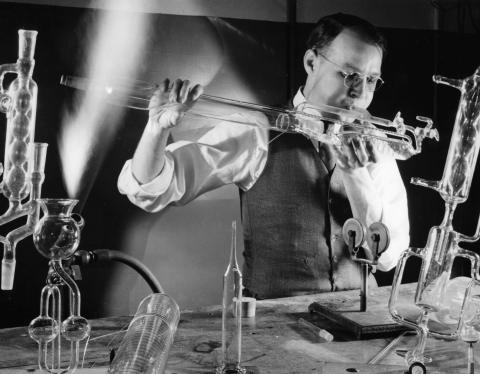
This ca. 1955 photograph shows a glass blower at DuPont's Experimental Station located near Wilmington, Delaware. The special apparatus required by researchers at the Experimental Station necessitated that the facility include a glass blower's shop, capable of making the unique and specialized complex equipment requested by laboratory staff.
This photograph was taken by William Maurice Rittase (1894-1968), a commercial photographer based in Philadelphia. Prior to World War I, Rittase worked as an engineer. During the war, he served as a Captain of the Artillery. At some point after his return from the war, he changed the course of his career and became a photographer.
By 1926, he was showing his work in photographic competitions in Maryland. During the 1930s, he worked at Fortune Magazine alongside the more famous Margaret Bourke-White, also known for photographic depictions of industry and industrial processes. Within our own collections at Hagley, his work can be seen documenting the activities of companies like DuPont, Budd Company, and Sperry-Rand.
This work by Rittase is part of Hagley Library's DuPont Company Product Information Collection (Accession 1972.371). In 1952, the DuPont Company organized a Product Information section within the Public Relations Department. Its main purpose was to create news releases accompanied by photographs that would be run editorially by trade journals and newspapers to create inexpensive publicity and indirect advertising.
To be used, the news releases had to include interesting information about a DuPont product, its development, manufacture, or applications. They could not be direct commercial promotions of a product itself as that would be the work of the Advertising Department. Product Information photographs and their news releases told the reader what DuPont did, why it was important, and sometimes, how it was done.
This collection has not been digitized in its entirety, but a selection of materials from it, mostly photographs taken from the 1930s through the 1950s, are available to view in our Digital Archive. Click here to take a look!

